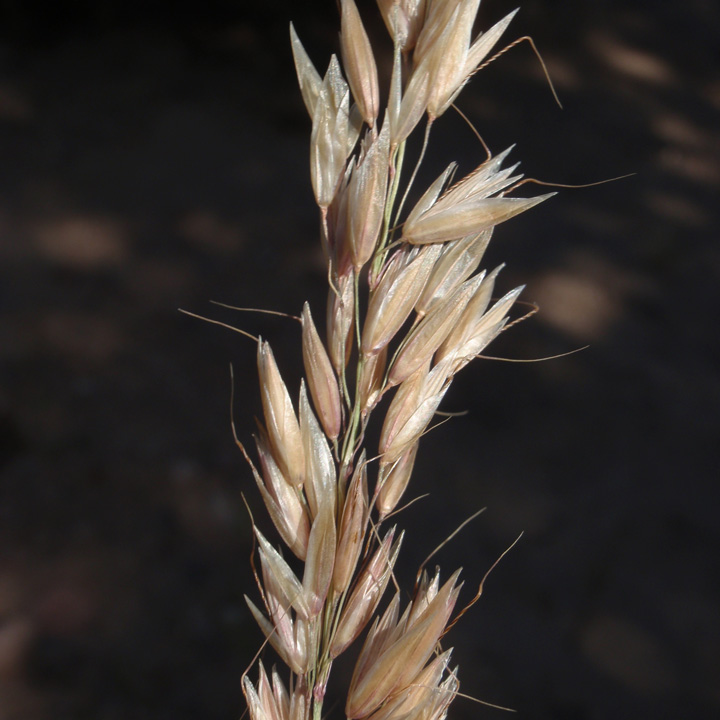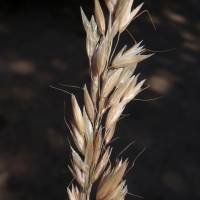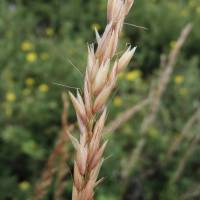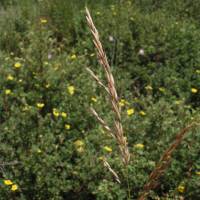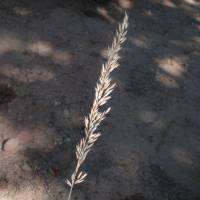Plants loosely cespitose, sometimes rhizomatous, rhizomes to 3 mm thick. Culms 50-140(180) cm, erect, glabrous, unbranched, basal internodes swollen or not swollen; nodes glabrous or occasionally puberulent to densely hairy. Sheaths smooth; ligules 1-3 mm, obtuse to truncate, usually ciliate; blades 5-32 cm long, (1)3-8(10) mm wide, flat, glabrous or rarely shortly pilose, sometimes scabrous. Panicles 7-30(36) cm long, 1-6(10) cm wide, green, shiny, becoming stramineous, sometimes purple-tinged; branches 15-20 mm, ascending to divergent, verticillate, usually spikelet-bearing to the base; pedicels 1-10 mm. Spikelets 7-11 mm; rachilla internodes to 0.7 mm, stout; rachilla prolongations 1.2-2 mm long, slender, apices often with a small, club-shaped rudiment. Glumes lanceolate to elliptic; lower glumes 4-7 mm; upper glumes 7-10 mm; callus hairs to 3.7 mm; lemmas (4)7-10 mm, apices bifid; awns of lower lemmas 10-20 mm, twisted below, often with alternating light and dark bands; awns of upper lemmas absent or to 5 mm long and arising just below the apices, rarely to 15 mm long and arising from above the middle; paleas 0.5-1 mm shorter than the lemmas, acute; anthers 3.6-5(6) mm. Caryopses 4-5 mm long, about 1.2 mm wide, ellipsoid, densely hairy, yellowish. 2n = 14, 28, 42.
Arrhenatherum elatius is grown as a forage grass and yields a palatable hay; it does not withstand heavy grazing. It readily escapes from cultivation and can be found in mesic to dry meadows, the edges of woods, streamsides, rock outcrops, and disturbed areas such as fields, pastures, fence rows, and roadsides. Varigated forms with the leaves striped green and white or yellow are cultivated as ornamentals. There are two subspecies, both of which have been found in the Flora region. Plants in which both lemmas have long, geniculate awns have been called A. elatius var. biaristatum (Peterm.) Peterm., but do not merit formal taxonomic recognition.
Tufted, short-lived perennial to 2 m; culms smooth, or minutely hairy at the nodes; sheaths smooth; blades scabrous, 4-8 mm wide; infl shining, slender, 1-3 dm, the short branches fascicled; glumes lance-ovate, acute or acuminate, the first 4.5-8 mm, the second 6.5-10 mm; lemmas glabrous or sparsely pilose; awn of the lower lemma 10-20 mm, geniculate near the middle; awn of the upper lemma 0-6 mm; anthers 4 mm; 2n=14, 28, 42. Meadows, roadsides, and waste ground, usually in moist soil; native of Europe, now widespread in the U.S. and found throughout our range. Plants with the lower internodes short, thickened into a series of subglobose corms 1 cm thick, are sporadic with us and have been distinguished as var. bulbosum (Willd.) Spenner.
Gleason, Henry A. & Cronquist, Arthur J. 1991. Manual of vascular plants of northeastern United States and adjacent Canada. lxxv + 910 pp.
©The New York Botanical Garden. All rights reserved. Used by permission.


